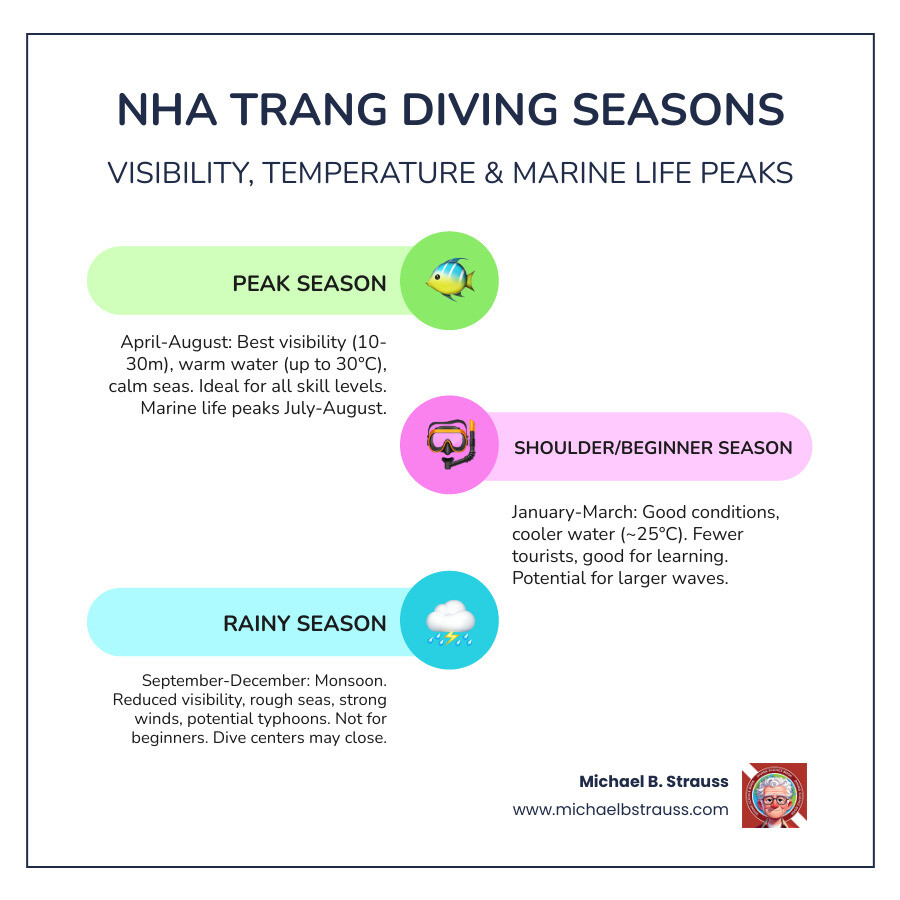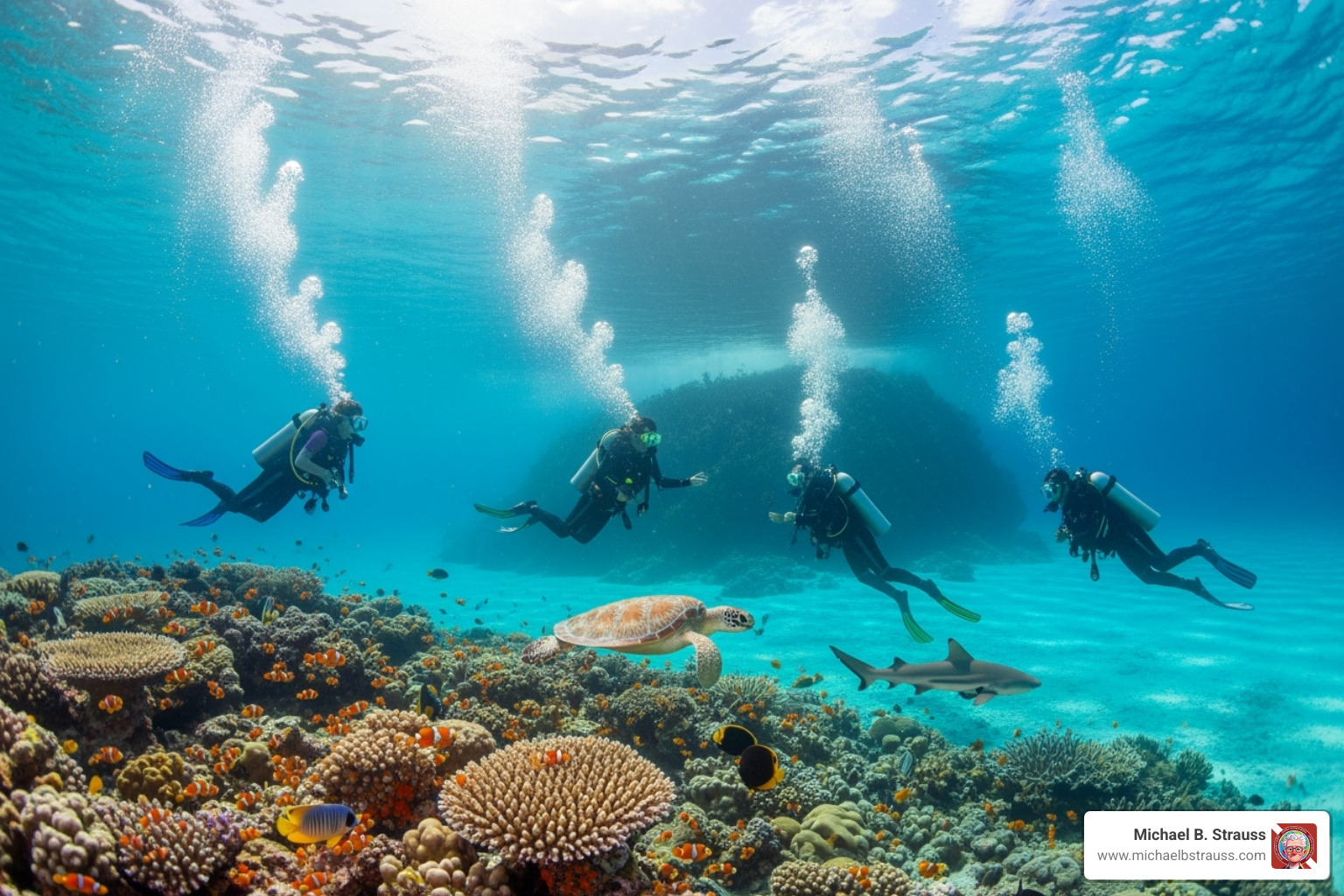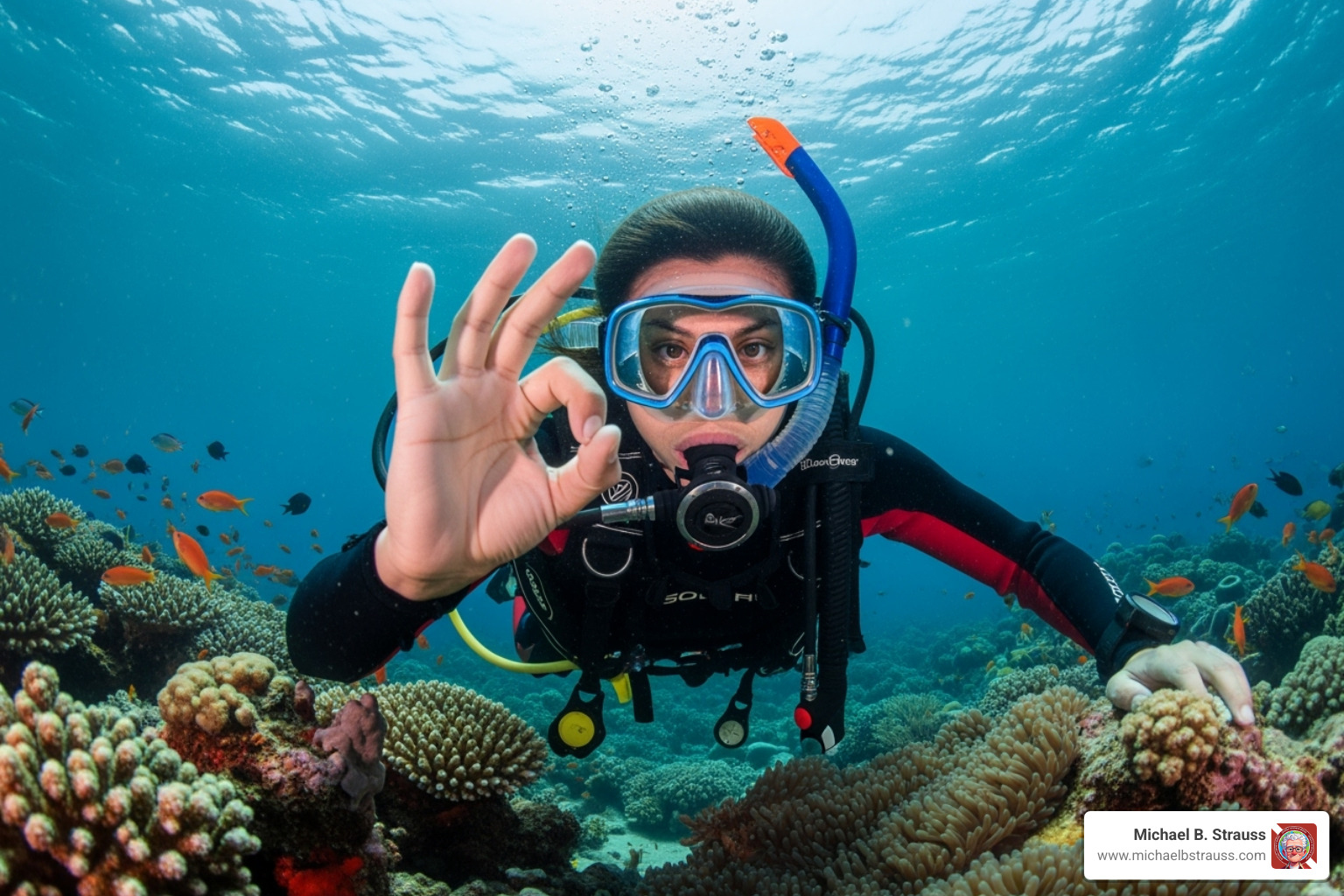Why Timing Your Nha Trang Dive Matters
Known as Vietnam's premier diving destination, Nha Trang offers crystal-clear waters and vibrant coral reefs. However, enjoying this underwater paradise depends entirely on timing your visit correctly. The nha trang diving season is dictated by a tropical climate with distinct wet and dry periods that dramatically affect visibility, currents, and safety.
Best Times to Dive in Nha Trang:
- Peak Season (April-August): Best visibility, calm seas, warm water.
- Good Season (January-March): Cooler water, fewer crowds, good for beginners.
- Avoid (September-December): Rainy season with poor visibility and rough seas.
Whether you're a seasoned diver from San Diego or a new enthusiast from Miami, understanding these seasonal shifts is key to planning a successful and safe trip. The city's Hon Mun Marine Park, home to over 300 coral species, is a world-class site, but its treasures are best and most safely explored when conditions are right.

A Complete Guide to the Nha Trang Diving Season
Understanding Nha Trang's distinct seasons is crucial for planning your dive trip. Conditions change dramatically, affecting everything from visibility to marine life. Knowing these nuances is as important as understanding your dive tables.
Peak Diving Season: April to August
This is the best time to dive in Nha Trang. As the dry season, these months offer optimal conditions: calm seas with minimal current, and excellent visibility often reaching 10-30 meters. Water temperatures are a warm 28-30°C, making for comfortable dives. The period from April to June is especially ideal for beginners getting certified, while July and August see a peak in marine life activity, perfect for underwater photographers. The renowned Hon Mun Marine Park is at its most spectacular during this time.

Shoulder & Beginner Season: January to March
This period marks the beginning of the dry season and is another great window for diving. The water is cooler (around 25.5°C), but the skies are clear and there are fewer tourists. This means less crowded dive sites, offering a more serene experience. While visibility is generally good, be aware that some sites may have stronger currents or larger waves, so it's important to consult with local dive operators. It remains a great time to learn to dive in a less crowded environment.
The Rainy Season: September to December
We advise caution when planning a dive trip during these months. The monsoon season brings rain, rough seas, and strong winds, which significantly reduce underwater visibility and can make boat travel uncomfortable. These conditions are not suitable for beginners, and even experienced divers may find them challenging. Furthermore, there is a higher risk of typhoons, which can lead to dive cancellations. While travel costs may be lower, the compromise in diving quality and safety is significant. For a deeper understanding of how weather impacts diving safety, explore our resources on diving science.
How the Nha Trang Diving Season Affects Marine Life
Nha Trang is a macro-lover's paradise, home to over 300 species of coral in the Hon Mun Marine Park alone. The focus here is on the small, intricate life rather than large pelagics. Look for colorful nudibranchs, frogfish, ghost pipefish, and various shrimp and crabs. Marine life is active year-round, but the peak abundance occurs from July to August when the water is warmest. Reduced visibility in the rainy season can make spotting these tiny critters more difficult.

Choosing Your Dive: Conditions for All Skill Levels
Nha Trang offers a variety of dive sites suitable for every experience level. With numerous certified dive centers, you'll find plenty of professional guidance. Here’s a quick look at some popular spots:
| Dive Site | Depth Range (m) | Best For | Key Features |
|---|---|---|---|
| Hon Mun Island | 10-30m | All levels | Protected marine park, 300+ coral species. |
| Hon Mot Island | 5-10m | Beginners, Snorkelers | Shallow, clear water for training. |
| Monkey Island | 3-5m | Beginners, Families | Very shallow, vibrant near-shore coral. |
| Octopus Rock | 20m+ | Experienced Divers | Challenging caves and rock formations. |
| Madonna Rock | Varies | All levels | Swim-throughs and small caves. |
| Moray Beach | Slopes to 18m | All levels, Training | Gentle slope, known for Giant Morays. |
Safety First: Navigating the Nha Trang Diving Season
No matter the season, safety is paramount. Whether you're diving in the kelp forests off California or the warm reefs of Nha Trang, the core principles of safe diving never change. Dr. Michael B. Strauss emphasizes that preparation and awareness are key to preventing incidents.
- Dive Within Your Limits: Always respect your training and experience level.
- Check Your Gear: Thoroughly inspect all equipment before every dive.
- Plan Your Dive: Understand the dive plan, safety procedures, and emergency protocols from your guide.
- Monitor Your Gauges: Constantly check your air, depth, and no-decompression time.
- Perform Safety Stops: A 3-minute stop at 5 meters (15 feet) is a critical habit.
- Stay Healthy: Don't dive tired or hungry, and stay hydrated. Use reef-safe sunscreen.
We strongly recommend diving with a certified guide and ensuring you have travel insurance that covers scuba diving, like policies from World Nomads. For a deeper understanding of dive safety and physiology, explore resources on topics like decompression sickness.
Plan Your Perfect Dive in Nha Trang
Now you have the knowledge to plan the perfect dive trip to Nha Trang. The key is matching the nha trang diving season to your skill level and expectations.
- For the best conditions, aim for the peak season from April to August. You'll be rewarded with calm, clear, and warm water, with marine life at its most active in July and August.
- For a quieter experience, the shoulder season from January to March offers a great alternative with fewer crowds, though the water is slightly cooler.
- We strongly advise against planning a primary dive trip from September to December due to the rainy season's poor visibility and rough seas.
A safe dive is a successful dive. This principle, central to the work of Dr. Michael B. Strauss, is universal. Whether you're exploring the wrecks off the Florida Keys or the reefs of Vietnam, always prioritize safety, dive within your limits, and trust your training. The underwater world of Nha Trang is a magnificent destination that's best enjoyed with proper planning and a healthy respect for the ocean's conditions.

For more expert advice and information to ensure every dive is a safe one, explore our diving resources. To dive deeper into the science behind safe diving, get your copy of "Diving Science, Revisited" from Best Publishing Company.
DISCLAIMER: Articles are for "EDUCATIONAL PURPOSES ONLY", not to be considered advice or recommendations.






